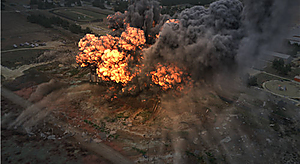Chemical fires, explosions and toxic releases occur every other day, on average, in the U.S. — but incidents like these can be prevented. For over a decade, our coalition has pushed the U.S Environmental Protection Agency to strengthen its Risk Management Program (RMP), which regulates an estimated 11,700 facilities that use and store large quantities of certain highly hazardous flammable and toxic chemicals.
In early 2021, President Biden directed the EPA to revise the RMP rule. Our coalition submitted public comments with detailed recommendations as to how to improve the RMP rule, and published a chemical incident tracker documenting over 900 hazardous chemcial incidents that occurred in the period 2021-2023 alone.
In March, 2023, the EPA finalized updates to the Risk Management Program rule that were responsive to our recommendations, and published a searchable database of RMP facilities for the first time.
Below are some of our priorities for a truly protective RMP rule:
Facilities Must Adopt Safer Alternatives
 EPA's Safer Technology and Alternatives Analysis (STAA) should require all RMP facilities to consider, document, and implement safer chemicals, processes and technology to improve safety. The best way to prevent chemical disasters is to reduce the amount of hazardous chemicals stored on site.
EPA's Safer Technology and Alternatives Analysis (STAA) should require all RMP facilities to consider, document, and implement safer chemicals, processes and technology to improve safety. The best way to prevent chemical disasters is to reduce the amount of hazardous chemicals stored on site.
Hazardous Chemical Facilities Need to Prepare for Climate Change
 Right now, nearly one-third of RMP facilities are located in areas at risk of flooding, storm surges, and wildfires. Updates to the EPA's RMP rule required facilities to explicitly assess such climate change threats in their risk management plans for the first time, but did not require RMP facilities to implement measures to prepare for these climate change threats, for example, by installing back-up power systems. Frequent hurricanes are already causing major chemical disasters, such as the Arkema chemical plant fire during Hurricane Harvey and a massive chlorine gas release from the Biolab facility during Hurricane Laura.
Right now, nearly one-third of RMP facilities are located in areas at risk of flooding, storm surges, and wildfires. Updates to the EPA's RMP rule required facilities to explicitly assess such climate change threats in their risk management plans for the first time, but did not require RMP facilities to implement measures to prepare for these climate change threats, for example, by installing back-up power systems. Frequent hurricanes are already causing major chemical disasters, such as the Arkema chemical plant fire during Hurricane Harvey and a massive chlorine gas release from the Biolab facility during Hurricane Laura.
Improved Emergency Response & Community Information
Hazardous chemical facilities are disproportionately located in communities of color and low-income communities. Between 2004 and 2021, more than 600,000 people have had to evacuate or shelter-in-place in their homes, workplaces and schools due to chemical releases, fires and explosions. Oftentimes, non-English speakers must cope with these emergencies without any information in their spoken language. For example, Spanish-speaking residents of Winston-Salem, North Carolina did not receive emergency notifications in their spoken language when 600 tons of ammonium nitrate caught fire at a fertilizer warehouse in 2022. We’re calling for EPA to create community emergency notification systems in multiple languages, require fenceline monitoring at all RMP facilities, and require more frequent emergency response planning exercises and coordination with first-responders.
Workers Must Be Treated as Key Prevention Partners
Thousands of worker injuries at RMP facilities have been reported in the last two decades, and some plant workers have lost their lives. Workers must be more deeply involved in the Risk Management Program, including hazard assessment, Safer Technology and Alternatives Analysis, incident investigation, third-party compliance audits, and emergency response. EPA should also authorize uniform Stop Work Authority for all workers at all RMP sites.
Expand the RMP to Cover More Processes and Chemicals
 Improper handling and storage of ammonium nitrate caused the 2013 West, Texas explosion and the 2020 Beirut explosion that destroyed entire neighborhoods. Ignoring the recommendations of the U.S. Chemical Safety and Hazard Investigation Board, the 2022 proposed rule does not expand the RMP to cover ammonium nitrate or any new reactive chemicals or lower the threshold for hazardous chemicals that would trigger coverage under the program. We call on EPA to commit to prompt action to update the list of covered hazardous chemicals as soon as possible.
Improper handling and storage of ammonium nitrate caused the 2013 West, Texas explosion and the 2020 Beirut explosion that destroyed entire neighborhoods. Ignoring the recommendations of the U.S. Chemical Safety and Hazard Investigation Board, the 2022 proposed rule does not expand the RMP to cover ammonium nitrate or any new reactive chemicals or lower the threshold for hazardous chemicals that would trigger coverage under the program. We call on EPA to commit to prompt action to update the list of covered hazardous chemicals as soon as possible.

